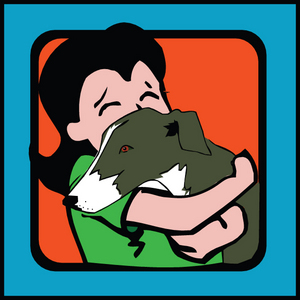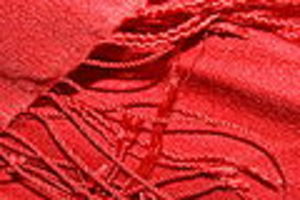Jessica Gates did a great job of imparting important information in her article, “Adopting the Retired Racing Greyhound.”
Although Greyhounds are fairly laid-back dogs, there are some things that make them different from other breeds of dogs. Sometimes the difference is life and death to the dog! For instance, Greyhounds can be somewhat trained to come when you call, but sooner or later something will spark their interest and the dog will keep running. That’s what they were bred to do: run! They are a “Sight Hound” and when they see something interesting, they lope along, oblivious to cars, their owner frantically calling them, etc.
I used to provide a foster home for retired racing Greyhounds. The organization I worked with often received a frantic call from an owner who had lost their dog. This organization would attach a tag with their phone number to the dog’s collar. Sooner or later a call would come in that someone had found the dog…and the tag. Sometimes the dog was dead, hit by a car. Other times the dog was alive and could be returned to its frantic owner. You can NEVER assume that your Greyhound will come back when you call, even when they are seemingly reliable. The Greyhound brain is wired in a funny way.: they are running machines and sooner or later they will start running, something will take their interest, and they will keep on going until they get hit by a car or are completely lost.
Another way in which Greyhounds are somewhat different is that they cannot tolerate some medicines and flea potions that other dogs can live with. For instance, Greyhounds need a special anesthesia if they go in for surgery. Propoflow leaves their systems very quickly and is the best anesthesia to use on them.
Greyhounds can die from the ingredients in a standard flea collar. Many flea medications can kill them! I used Programto keep the flea population down. We lived in a house in the woods and fleas were all around outside. Our local raccoon, squirrel and deer population kept the fleas alive and well fed. Programwas my secret weapon. It didn’t hurt the Greyhounds, and effectively rendered the fleas sterile. Program requires a prescription from your veterinarian. Once you have that, you can purchase it on-line at Drs. Foster Smith.com.
Greyhounds almost always end up needing special dental care from a vet. Their teeth seem to be more prone to plaque and decay than some other breeds. If you adopt a Greyhound, assume you will need to pay for dental care sooner or later!
How good is Adopting the Retired Racing Greyhound by Cynthia Branigan? This book was given to each person who adopted a Greyhound by the Greyhound adoption association I worked with! It is an excellent reference manual.
Greyhounds are lovable, and usually quite pragmatic. The ones I have known had a droll sense of humor, and were very calm dogs. When other dogs in a household tend to bark and cause a ruckus, the Greyhound usually is the one eye-balling the other dogs with a pained look. They seem to be saying, “What’s all the fuss? Chill out!”
I ended up adopting Cassie, an older smallish Greyhound who had experienced a hard life. Cassie’s former owner didn’t take good care of her teeth. A tooth cleaning is a bit expensive! It helps to work with Greyhounds until they will allow you to brush their teeth regularly to keep their dental work to a minimum.
Poor Cassie had terrible dental problems and she was very thin when she came to live with us. She seemed depressed. Our Standard Poodle had an irrepressible zest for life. Cassie would watch the Poodle’s antics and after a while Cassie started smiling too. The stench from Cassie’s mouth was unbelievable! It filled the room and moved on to the next room as well. After a month or two, when Cassie had put on some weight and was settled in our household, she was taken to the vet for dental surgery. The vet anesthetized Cassie and started removing many diseased teeth. I was told later that the surgical team had to stop and take the teeth they’d removed out of the room – the smell was overwhelming! From then on Cassie had to have soft food because she had so few teeth left in her head. Cassie started out as a foster dog, but we adopted this sweet dog after falling in love with her, and she spent the rest of her life with us. She came to be a joyful, happy and healthy dog in her senior years.
Harold was a foster dog that we cared for. He was a large, black and white, slightly grumpy Greyhound – the Walter Matthau of the dog world. We called him “Weird Harold.” Like most Greyhounds, he was pretty quiet. But Harold was sneaky! He was a tall dog, and when he stood on his back legs he could eat off the kitchen counters.
This came in handy for Harold the day that I made a huge banana cream sheet cake for a family member’s birthday. Harold snuck into the kitchen and, yup, you guessed it, he gobbled up quite a bit of the cake. I walked back into the kitchen a moment too late to find about half of a full sheet cake missing. That’s a lot of cake. I was so mad at that dog! The dog didn’t even get sick from all the cake and whipping cream.
Month after month no one stepped up to adopt Harold. I worried that we’d have him for the rest of his natural life. Then, like a miracle, a mother-daughter team showed up. They already had a cranky old male Greyhound, and were looking for another. Go figure! I heard later that Harold and their dog got along just fine. Two grumpy old men, probably both noshing off the kitchen counters.
Our Greyhounds were definitely not watch dogs! They were friendly to everyone and didn’t understand the concept of guarding a house or yard. Many Greyhounds will chase cats or other smaller animals, and some will kill them, not out of meanness, but simply because that is what they are bred to do, as all Sight Hounds are: run after the fleeing quarry, grab it by the neck, and make a U-turn, neatly snapping the neck of the hapless rabbit (or cat). Other Greyhounds learn to live side-by-side with cats.
Our dogs were very good with our big Ragdoll cat, however the cat didn’t run much. Once Ragdoll cats are fully grown, they tend to be couch potatoes, developing large fat pads on their undersides. If you own a cat and are considering adopting a Greyhound, it is crucial to adopt a Greyhound who has already been around cats and who is good with them! Many Greyhounds have been in foster care after the track. That gives the adoption agency the opportunity to evaluate the individual dog, and gives the dog a chance to get used to flushing toilets, stairs, dishwashers, vacuum cleaners, and so on. Some dog tracks will run dogs up a stair-like contrivance, and when the dogs go up the stairs, a person reaches from the other side of the “stairs” to clip the dog’s toenails. Sometimes the toenails are clipped too short (ouch!). Some Greyhounds are leery of stairs until they figure out that no one is going to grab them.
Greyhound hair is pointy on one end, and it tends to go into things like an arrow. You end up with short Greyhound hairs in your couch fabric and in the rug. If the dog is brushed regularly, it won’t shed as much as it otherwise would. Our Greyhounds were taught to hop into the tub and stand quietly on a rubber bath mat while we bathed them. Tubs are very slick and distressing to a dog, so it is important to always give them a rubber mat to stand on! No one likes to have their legs sliding out from under them. It would be like a human losing their balance on ice.
Greyhounds are strictly indoor dogs! Their short coat leaves them vulnerable to temperature changes, and they crave companionship. They would be very depressed if they were to be shut out of their home! After life on the track, they seem to know what they want, even if they have never experienced it before.
Our Greyhounds were excellent in the car. None of them ever became carsick, like the Standard Poodle did. Greyhounds love to go for car rides! In addition, the dogs wore doggy t-shirts and bomber jackets with great style. They loved it when people would come up to them and make a big fuss over them. We’ve taken Greyhounds to art festivals at the beach and soccer games in the park. They dogs were quiet, calm, and fairly unflappable.
One bumper sticker pretty much says it the way it is: “Greyhounds: 45 mile per hour couch potatoes!” This bony breed just loves a soft place to lie down! The softer, the better! They will get comfortable on their back with all four feet in the air and go to sleep that way. These sweet dogs often have a wonderful sense of humor and they truly appreciate a loving home. If you are patient and kind, your Greyhound will try very hard to please you and will be an adoring pet for the rest of its life.




